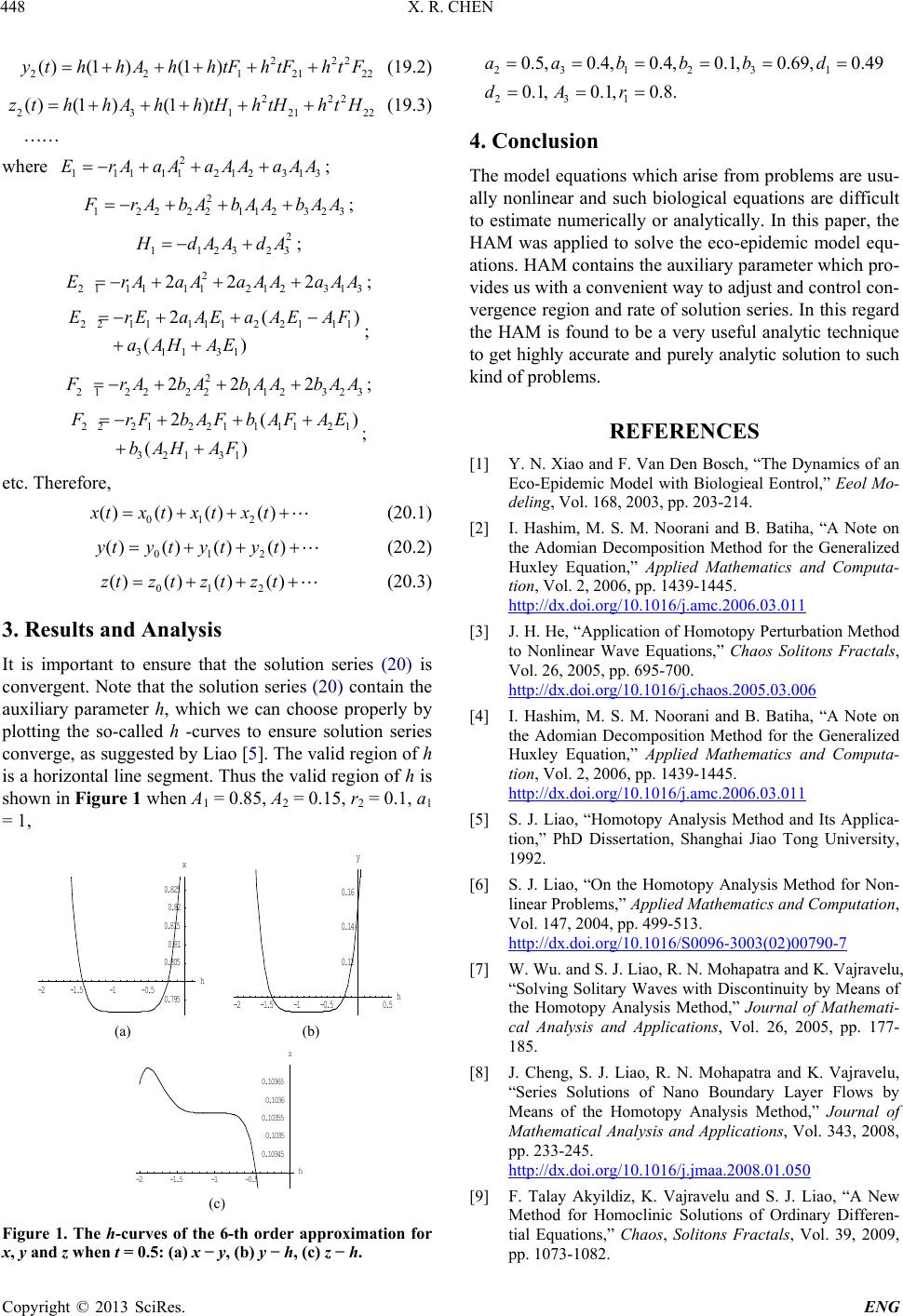
X. R. CHEN
Copyright © 2013 SciRes. ENG
2 22
2212122
()(1 )(1 )ythhAhhtFh tFh tF=+++++
(19.2)
2 22
231 2122
()(1 )(1 )zthhAhhtHh tHh tH=+++++
(19.3)
where
2
111 11212313
ErAaAa AAaAA=−+ ++
;
2
122 22112323
F rAbAbAAbAA=−+ ++
;
;
2
21 1111212313
22 2ErAaAa AAaAA=−+ ++
;
22111112 2111
31 131
2( )
()
ErEaAEa AEAF
a AHAE
=−+ +−
++
;
2
21 2222112323
22 2FrAbAbAAbAA=−+ ++
;
22212 2111121
32131
()
FrFbAFbAFAE
b AHAF
=−++ +
++ ;
etc. Therefore,
012
()() ()()xtxtxtxt=+++
(20.1)
012
()() ()()ytytytyt= +++
(20.2 )
012
()()()()ztztztzt= +++
(20.3 )
3. Results and Analysis
It is important to ensure that the solution series (20) is
convergent. Note that the solution series (20) contain the
auxiliary parameter h, which we can choose properly by
plotting the so-called h -curves to ensure solution series
converge, as suggested by Liao [5]. The valid region of h
is a horizontal line segment. Thus the valid region of h is
shown in Figure 1 when A1 = 0.85, A2 = 0.15, r2 = 0.1, a1
= 1,
(a) (b)
(c)
Figure 1. The h-curves of the 6-th order approximation for
x, y and z when t = 0.5 : (a) x − y, (b) y − h, (c) z − h.
2 31231
2 31
0.5,0.4, 0.4,0.1,0.69,0.49
0.1,0.1, 0.8.
a abbbd
d Ar
== == ==
== =
4. Conclusion
The model equations which arise from problems are usu-
ally nonlinear and such biological equations are difficult
to estimate numerically or analytically. In this paper, the
HAM was applied to solve the eco-epidemic model equ-
ations. HAM contains the auxiliary parameter which pro-
vides us with a convenient way to adjust and control con-
vergence region and rate of solution series. In this regard
the HAM is found to be a very useful analytic technique
to get highly accurate and purely analytic solution to such
kind of pro blems.
REFERENCES
[1] Y. N. Xiao and F. Van Den Bosch, “The Dynam ics of an
Eco-Epidemic Mod el with Biologieal Eontrol,” Eeol Mo-
deling, Vol. 168, 2003, pp. 203-214.
[2] I. Hashim, M. S. M. Noorani and B. Batiha, “A Note on
the Adomian Decomposition Method for the Generalized
Huxley Equation,” Applied Mathematics and Computa-
tion, Vol. 2, 2006, pp. 1439-1445.
http://dx.doi.org/10.1016/j.amc.2006.03.011
[3] J. H. He, “Application of Homotopy Perturbation Method
to Nonlinear Wave Equations,” Chaos Solitons Fractals,
Vol. 26, 2005, pp. 695-700.
http://dx.doi.org/10.1016/j.chaos.2005.03.006
[4] I. Hashim, M. S. M. Noorani and B. Batiha, “A Note on
the Adomian Decomposition Method for the Generalized
Huxley Equation,” Applied Mathematics and Computa-
tion, Vol. 2, 2006, pp. 1439-1445.
http://dx.doi.org/10.1016/j.amc.2006.03.011
[5] S. J. Liao, “Homotopy Analysis Method and Its Applica-
tion,” PhD Dissertation, Shanghai Jiao Tong University,
1992.
[6] S. J. Liao, “On the Homotopy Analysis Method for Non-
linear Problems,” Applied Mathematics and Computation,
Vol. 147, 2004, pp. 499-513.
http://dx.doi.org/10.1016/S0096-3003(02)00790-7
[7] W. Wu. and S. J. Liao, R. N. Mohapatra and K. Vajravelu,
“Solving Solitary Waves with Discontinuity by Means of
the Homotopy Analysis Method,” Journal of Mathemati-
cal Analysis and Applications, Vol. 26, 2005, pp. 177-
185.
[8] J. Cheng, S. J. Liao, R. N. Mohapatra and K. Vajravelu,
“Series Solutions of Nano Boundary Layer Flows by
Means of the Homotopy Analysis Method,” Journal of
Mathematical Analysis and Applications, Vol. 343, 2008,
pp. 233-245.
http://dx.doi.org/10.1016/j.jmaa.2008.01.050
[9] F. Talay Akyildiz, K. Vajravelu and S. J. Liao, “A New
Method for Homoclinic Solutions of Ordinary Differen-
tial Equations,” Chaos, Solitons Fractals, Vol. 39, 2009,
pp. 1073-1082.
-2 -1.5 -1 -0.5h
0.795
0.805
0.81
0.815
0.82
0.825
x
-2 -1.5-1 -0.50.5 h
0.12
0.14
0.16
y
-2 -1.5-1 -0.5 h
0.10345
0.1035
0.10355
0.1036
0.10365
z